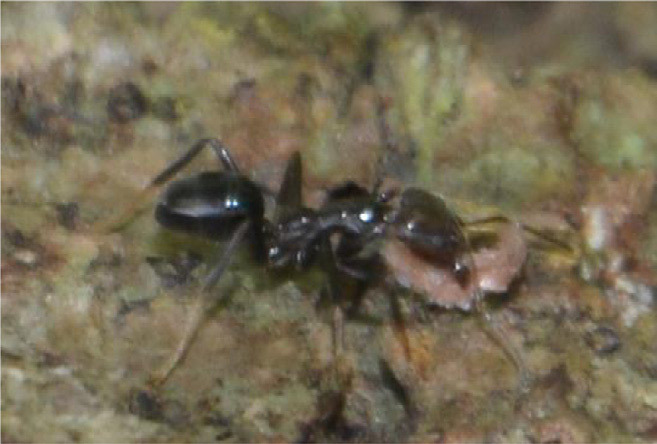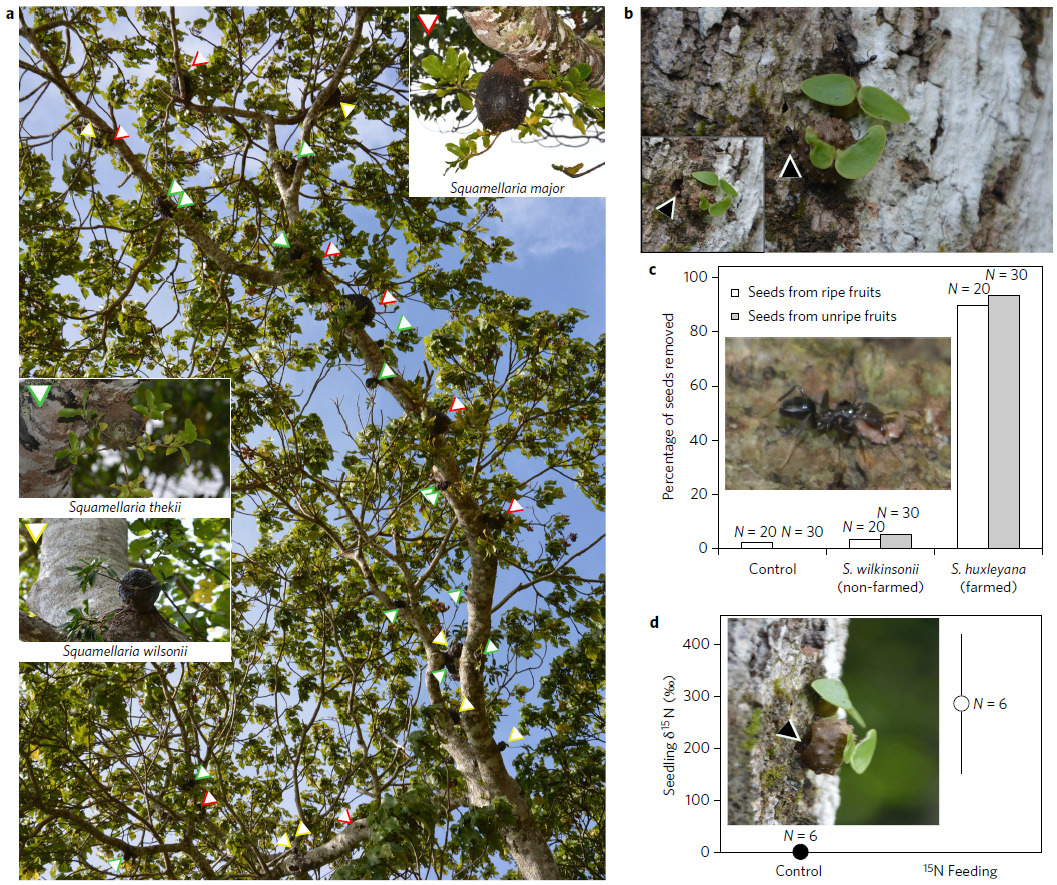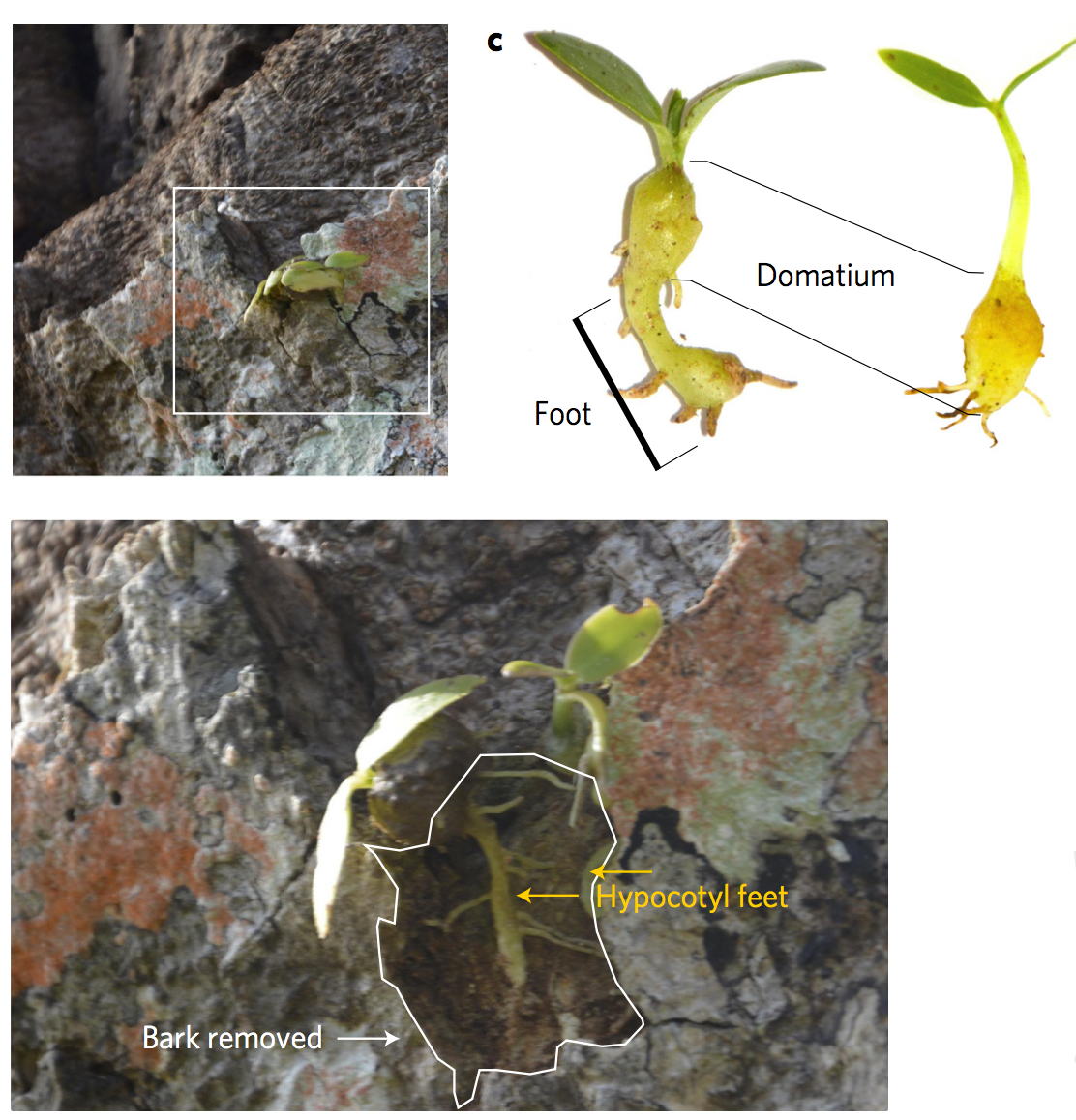Ants in Fiji learned how to grow fruit about 3 million years ago.

A worker ant drags a Squamellaria seed to the landing site.
In some respects, social insects are far ahead of man. For example, termites have mastered agriculture - cultivation of fungi on plantations - 25 million years ago, long before this discovery was made by a reasonable person.
Other social insects - ants - keep up with termites in resourcefulness. Myrmecologists have discovered on the Fiji Islands a previously unknown species of ants, Philidris nagasau , which deals with absolutely amazing things.
The ants of Philidris nagasau have mastered agriculture at a more advanced level than termites. Scientists estimate that these ants improve their farming skills for millions of years. Insects do not just grow Squamellaria fruits for food, but live in them. Apparently, this is the most difficult form of agriculture among all the animals studied so far.
')
Squamellaria is a member of the madder family. Representatives of this family are usually rich in caffeine and other alkaloids. To the same family belongs the coffee tree. Although caffeine is a toxic substance and a powerful insecticide, this does not prevent ants from eating and living in Squamellaria . Probably in the process of evolution, they somehow adapted to this insecticide or in Squamellaria just a little caffeine.
Scientists believe that the ant symbiosis of Philidris nagasau and Squamellaria is obligate. This is a form of symbiosis in which in vivo populations cannot exist without each other. The proof is the fact that 100% of the studied specimens of Squamellaria of six species (S. grayi, S. huxleyana, S. imberbis, S. major, S. Thekii, S. wilsonii) are inhabited by ants Philidris nagasau . They are either processed by workers, or are the location of the colony. A total of 866 plants were investigated. On the other hand, the ants of Philidris nagasau are not found anywhere else except on these trees. These two facts indicate an obligate character of symbiosis: that is, ants are obliged to grow the fruits of this species and live in them, otherwise they cannot live.

Examples of Squamellaria, colonized by ants
The production cycle of agriculture is organized as follows. Ants find the seeds of Squamellaria and gently plant them in the cracks of the bark of a tree. According to the observations of scientists, ants take care of the sprouts and wait a long time for the plants to grow. Then the ants fertilize them and wait for the fruit to ripen. Despite long-term observations, scientists did not manage to notice how ants fertilize plants. They suggest that the working individuals defecate in the house - a small cavity near the stem of the plant.

It is surprising that in the first weeks the ants do not receive any direct benefit from these plants, so caring for the seedlings is a long-term strategy. In the same way, people take care of the vegetable shoots, knowing exactly what they will get in the future.
The ants somehow possess this knowledge of a long-term strategy. According to scientists, this is an innate quality. The fact is that myrmecologists have previously known cases in which ants grow fruits or learn to build a colony using improvised means. But in these cases, this behavior was acquired. The ants passed on knowledge for several generations, but sooner or later this knowledge disappeared, so that the colony could not continue research activities using past practices. I had to start all over again using trial and error.
In the case of the ants Philidris nagasau, the situation is different. This species has been involved in such activities for millions of years. So, such a strategy is their innate skill.

Residential cameras built by ants inside the fruit of Squamellaria
After the fruit ripens, the ants collect the seeds and plant them in other places on the tree. Scientists have determined that of the six species of Squamellaria, ants are trying to choose seeds of a certain type. Obviously more suitable for life. In the process of maturation, the ants continue to fertilize the plant. In the end, they get sugar-rich fruit as food and a place to live.
This is an amazing example of an obligate symbiosis between a certain plant and a certain type of ants. Scientists reconstructed the evolutionary history of Philidris nagasau and found that these two species coexist, probably for three million years. At this point, both the ants and the plant Squamellaria simultaneously evolved in such a way that symbiosis became possible. The plant has a special root system that allows it to sprout in the cracks of the bark of trees. And the ants have mastered the cultivation of plants and the construction of homes inside the fruit. Experts suggest that some changes in the plant occurred as a result of targeted mutations and long-term cultivation, which was carried out by ants.
In other words, for several million years of stubborn cultivation, ants accidentally or specifically brought out a form of Squamellaria that is most convenient for life and the most tasty. By the same method of cultivation before the advent of genetic engineering, people cultivated the most preferred plant varieties.

In the future, scientists are going to study in detail the chemical signaling system that ants use to coordinate their actions during agricultural activities.
These termites and ants are not the only creatures that have mastered agriculture. For example, leaf-cutting ants in North and South America about 10 million years ago, began to grow in anthills mushrooms Leucocoprinus of family Agaricaceae, fertilizing them milosferami of cut worker ants leaf chewed mass (ants genus Atta cultivated fungi of the genus Leucoagaricus (leucoagaricus), ants genus Acromyrmex - Mushrooms Leucocoprinus (belonozniki)).
The scientific article was published on November 21, 2016 in the journal Nature Plants (doi: 10.1038 / nplants.2016.181, pdf ).
Source: https://habr.com/ru/post/399501/
All Articles